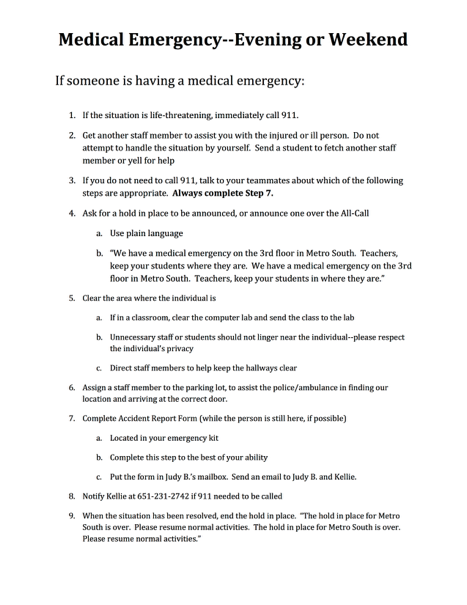Safety and Security: Forming and Leading the Community Ed Campus Building Emergency Response Team
Situation: In the fall of 2013, I was asked to lead our Community Education Campus (CEC) Building Emergency Response Team (BERT). Prior to this, we had no plan, no procedures, and improvised responses to emergencies.
Unique Partners: Our CEC building is shared with two other tennants, General Dynamics (a large defense contractor) and Ramalynn Academy (a private school). General Dynamics controls most of our building, including two of the three Safe Harbor hallways. General Dynamics has strict security requirements. Ramalynn has built their business by distancing and differentiating themselves from the public school system, and would prefer to have minimum contact with our school district. The building itself is managed by a 3rd party group, CBRE. CBRE controls the building access and emergency systems.
Resources: With the passage of Bloomington's 2013 Safety and Security levy, Paul McCullough was hired by the District as a consultant. Paul is a retired Bloomington police officer with expertise in school emergency planning. We formed our BERT team with representatives from each of our CE programs in the building. One advantage we have is a large number of staff members that aren't assigned to specific classes. These staff members took up the challenge of being on the BERT team and performing different tasks in each of our four emergency conditions.
Unique Students and Situations: Our CEC building has many unique student groups. We have a deaf class, many adults learning English, many immigrants who may be unfamiliar with our emergency practices, and, beginning in 2014, a Transitions program for students with disabilities between the ages of 18 and 21. Our students are also in the building six days a week, with many classes meeting in the evenings. Our evening classes have no leadership team members on site in most circumstances. In 2015, we added 11th and 12th graders taking classes at our College and Career Academy to the mix.
All of this lead to a complex mix of needs that required some creative problem-solving. An example of that was using a strobe light to signal a lockdown for our deaf class. The strobe is activated remotely from two of our other classrooms. The deaf class may also initiate a lockdown with strobes in the other two classrooms.
Drill Requirements: State statute requires us to perform five fire drills, five lockdown drills, and one tornado drill each year. This 5/5/1 format is a minimum. Our program has four unique schedules of classes (M/W nights, T/Th nights, weekdays, and Saturdays) with very little crossover between schedules. Each group needs to be drilled with enough frequency to remain familiar with the procedures. In our first two years, we conducted more than twenty drills each year across those four schedules.

Preparing Students: Classroom presentations were prepared with each instructional level in mind. I initially presented in each class in the week before a drill. After that, the presentations were handed off to the classroom teachers to use prior to each drill.
My Role: As the team leader, I drafted each of our procedures and presented them to the team. We made changes to reflect the unique needs of each of our programs. I also coordinated our drills with our interal and external partners. I was present as an observer for most of our drills from 2013-2015. After each drill, we'd gather the invovled BERT team members and debrief about what went well and what needed improvement. I also coordinated the supplies for our classroom emergency kits, hallway signage, and BERT team member radios.
Outcome: CEC has a robust set of emergency procedures and capabilities. We've successfully coordinated with our partners, completed more than our required number of drills, and have handled a number of emergency situations extremely well.